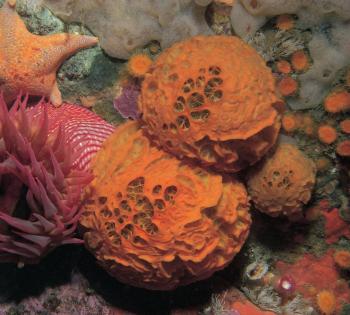
Sedentary marine animals need chemical compounds to deter predation, to communicate with their neighbors, or to prevent algae and bacteria from growing on top of them. Tens of thousands of unique biochemical compounds have been isolated from sea creatures, many of which have led to the development of effective and life-saving drugs.
Sponges are thought to be a treasure trove of compounds to research for new drug discovery because the majority of species are completely sedentary and over their more than half a billion-years on earth must have evolved defenses.
When scientists have screened cells from sponge tissues they found compounds with the potential for an incredible range of medicinal properties including: antibacterial, antiviral, antifungal, antimalarial, antitumor, immunosuppressive, and cardiovascular activity.
Anti-Viral and Anti-Cancer
One of the earliest compounds found in sponges was found in the Caribbean sponge Tectitethya crypta, which has been studied since the 1950s.The first anti-leukemia drug was developed from two chemicals found in this sponge.
Recently a compound from an Indo-Pacific sponge was found to slow the proliferation of cervical, prostate and other cancer cells, while allowing normal healthy cells to continue replicating. This same compound, Manzamine A, destroys and inhibits the Herpes virus.
HIV-AIDS
Another drug from the Caribbean sponge’s Tectitethya crypta compounds includes the HIV drug AZT, a breakthrough in AIDS treatment in the late 1980s
Covid-19
Remdesivir, a drug used to treat Covid-19 was derived from that same sponge Tectitethya crypta. Doctors first used Remdesivir to fight the Ebola (also a coronavirus). It seems to be effective at modestly shortening recovery time by four days, on average, but did not reduce fatalities of Covid-19.
Collecting and Protecting Sponges
Scientists make copies of the useful chemicals they extract from sponges, so they won’t have to constantly harvest new sponges from the ocean, hoping to leave our marine ecosystems healthy and intact. But bioprospecting continues to harvest marine organisms as scientists carry on their search for novel pharmaceuticals.
Will any profits from these new drugs go towards protecting marine biodiversity? There needs to be more support for Marine Protected Areas and for the communities that are stewards of those areas of high diversity Our Featured Scientist, Cristina Diaz, hopes to work with the Kuna indigenous community in Panama to grow sponges for drug discovery.
By Nancy Burnett and Natasha Fraley
















